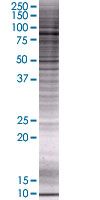MeCP2 overexpression 293T lysate (whole cell) (ab94140)
Overview
-
Product name
MeCP2 overexpression 293T lysate (whole cell) -
General notes
ab94140 is a 293T cell transfected lysate in which Human MeCP2 has been transiently over-expressed using a pCMV-MeCP2 plasmid. The lysate is provided in 1 x Sample Buffer. Note: For more details about how the transfected lysate was prepared view preparation notes
-
Tested applications
Suitable for: WBmore details
Properties
-
Mycoplasma free
Yes -
Form
Liquid -
Storage instructions
Shipped on dry ice. Upon delivery aliquot and store at -20ºC. Avoid freeze / thaw cycles. -
Storage buffer
Constituents: 0.01% Bromophenol blue, 2.3% Beta mercaptoethanol, 2% Sodium lauryl sulfate, 0.788% Tris HCl, 10% Glycerol (glycerin, glycerine) -
 Concentration information loading...
Concentration information loading... -
Research areas
-
Background
Disease: Defects in MECP2 may be a cause of Angelman syndrome (AS) [MIM:105830]; also known as happy puppet syndrome. AS is a neurodevelopmental disorder characterized by severe mental retardation, absent speech, ataxia, sociable affect and dysmorphic facial features. AS and Rett syndrome have overlapping clinical features. Defects in MECP2 are the cause of mental retardation syndromic X-linked type 13 (MRXS13) [MIM:300055]. Mental retardation is a mental disorder characterized by significantly sub-average general intellectual functioning associated with impairments in adaptative behavior and manifested during the developmental period. MRXS13 patients manifest mental retardation associated with other variable features such as spasticity, episodes of manic depressive psychosis, increased tone and macroorchidism. Defects in MECP2 are the cause of Rett syndrome (RTT) [MIM:312750]. RTT is an X-linked dominant disease, it is a progressive neurologic developmental disorder and one of the most common causes of mental retardation in females. Patients appear to develop normally until 6 to 18 months of age, then gradually lose speech and purposeful hand movements and develop microcephaly, seizures, autism, ataxia, intermittent hyperventilation, and stereotypic hand movements. After initial regression, the condition stabilizes and patients usually survive into adulthood. Defects in MECP2 may be the cause of susceptibility autism X-linked type 3 (AUTSX3) [MIM:300496]. AUTSX3 is a pervasive developmental disorder (PDD), prototypically characterized by impairments in reciprocal social interaction and communication, restricted and stereotyped patterns of interests and activities, and the presence of developmental abnormalities by 3 years of age. Defects in MECP2 are the cause of encephalopathy neonatal severe due to MECP2 mutations (ENS-MECP2) [MIM:300673]. Note=The MECP2 gene is mutated in Rett syndrome, a severe neurodevelopmental disorder that almost always occurs in females. Although it was first thought that MECP2 mutations causing Rett syndrome were lethal in males, later reports identified a severe neonatal encephalopathy in surviving male sibs of patients with Rett syndrome. Additional reports have confirmed a severe phenotype in males with Rett syndrome-associated MECP2 mutations. Defects in MECP2 are the cause of mental retardation syndromic X-linked Lubs type (MRXSL) [MIM:300260]. Mental retardation is characterized by significantly below average general intellectual functioning associated with impairments in adaptative behavior and manifested during the developmental period. MRXSL patients manifest mental retardation associated with variable features. They include swallowing dysfunction and gastroesophageal reflux with secondary recurrent respiratory infections, hypotonia, mild myopathy and characteristic facies such as downslanting palpebral fissures, hypertelorism and a short nose with a low nasal bridge. Note=Increased dosage of MECP2 due to gene duplication appears to be responsible for the mental retardation phenotype. Function: Chromosomal protein that binds to methylated DNA. It can bind specifically to a single methyl-CpG pair. It is not influenced by sequences flanking the methyl-CpGs. Mediates transcriptional repression through interaction with histone deacetylase and the corepressor SIN3A. PTM: Phosphorylated on Ser-423 in brain upon synaptic activity, which attenuates its repressor activity and seems to regulate dendritic growth and spine maturation. Similarity: Contains 2 A.T hook DNA-binding domains. Contains 1 MBD (methyl-CpG-binding) domain. Tissue specificity: Present in all adult somatic tissues tested.
Images
-
ab94140 at 15µg/lane on an SDS-PAGE gel.
-
All lanes : Anti-MeCP2 antibody (ab55538) at 1/500 dilution
Lane 1 :MeCP2 overexpression 293T lysate (whole cell) (ab94140)
Lane 2 : 293T non-transfected lysate
Lysates/proteins at 25 µg per lane.
Secondary
All lanes : Goat Anti-mouse IgG (H and L) HRP conjugated at 1/2500 dilution









